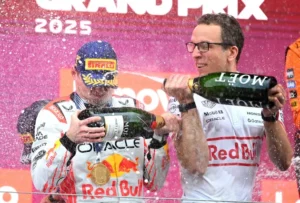Just in:Vital F1 Championship Initiative Reveals ….read more

Vital F1 Championship Initiative Reveals ….read more
New research from the groundbreaking motorsport initiative More than Equal has delivered a surprising verdict on gender equality in one particular racing series, uncovering significant disparities within Formula 1 (F1) but also highlighting a surprising success story in a different motorsport: drag racing.
Founded by 13-time Grand Prix winner David Coulthard and entrepreneur Karel Komarek, More than Equal has one primary aim: to find the first female Formula 1 World Champion. The initiative conducts research into gender equality across motorsport, focusing on identifying barriers that prevent women from advancing to the highest echelons of racing. Recent findings from More than Equal’s latest research report have cast a stark light on the gender gap in F1, revealing that female drivers currently make up only 4% of the elite motorsport population.
This alarming statistic highlights a persistent issue in motorsport, where women remain severely underrepresented in the upper echelons of racing. F1, widely considered the pinnacle of motorsport, has not seen a female driver participate in a competitive race session since the mid-1970s. This absence is even more pronounced when compared to other forms of motorsport that have seen greater gender diversity. Despite occasional efforts and some pioneering female drivers, Formula 1 has failed to break down the barriers that prevent women from making it into the sport’s highest ranks.
The More than Equal report sheds light on several significant challenges facing female drivers. One of the main barriers identified is limited track time. Female drivers often struggle to access the same amount of driving opportunities as their male counterparts, which directly impacts their chances of progressing through the ranks. Testing opportunities, which are crucial for gaining experience and improving skills, are frequently limited for women, especially in elite racing series like F1. Additionally, sponsorship remains a key issue. Motorsport is a highly expensive sport, and securing backing from sponsors is often the difference between a career that flourishes and one that stalls. Female drivers, however, often face difficulties attracting sponsorship due to persistent gender biases and a lack of visibility.
Despite these obstacles, More than Equal’s research uncovered a surprising area of motorsport where gender equality is far ahead of F1—drag racing. Unlike F1, where women are still fighting to gain a foothold, drag racing has made significant strides in ensuring greater gender inclusivity. The National Hot Rod Association (NHRA), the largest drag racing governing body in the world, has been highlighted as a model of gender equality. Founded in 1951, the NHRA has long supported female participation, and drag racing itself has become one of the more inclusive motorsport disciplines. Female drivers in the NHRA compete alongside their male counterparts in the same events, and the sport has seen several women excel at the highest levels.
This progress is not only limited to the NHRA but extends to European drag racing as well. In collaboration with Santa Pod Raceway, Europe’s first permanent drag strip, and Women in Motorsports North America (WIMNA), More than Equal’s research has demonstrated how drag racing is leading the way in gender equality. Female drivers in drag racing benefit from equal track time, recognition, and sponsorship opportunities, providing a platform for their talents to flourish. The emphasis in drag racing is on raw speed, precision, and reaction times—factors that are not influenced by gender, allowing female competitors to showcase their skills on equal terms.
This striking contrast between F1 and drag racing underscores the challenges that still remain for women in elite motorsport. While drag racing has made remarkable strides toward gender parity, F1 lags behind, struggling with outdated perceptions and systemic barriers that hinder female drivers. The findings call for greater action from both governing bodies and the wider motorsport industry to level the playing field for women.
The More than Equal initiative’s research provides a powerful reminder of the work still needed to create a more inclusive environment in motorsport, particularly in series like Formula 1. As the quest for the first female Formula 1 World Champion continues, initiatives like More than Equal are essential for driving change and challenging the status quo in the world’s most prestigious racing series. By highlighting the success of drag racing as a case study, the initiative hopes to inspire further progress across all forms of motorsport and encourage greater opportunities for female drivers to compete at the highest levels.
Ultimately, the goal remains clear: to see a female driver stand on the top step of the podium in Formula 1—and for that dream to no longer seem out of reach.








